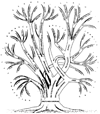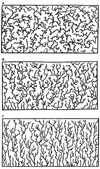FRACTAL VASCULAR GROWTH PATTERNS
Abstract
Flow distributions in the heart and lung are heterogeneous but not at all random. The apparent degree of heterogeneity increases as one reduces the size of observable elements; the fact that the dispersion of flows shows a logarithmic relation to element size says that the system is statistically fractal. The fractal characterization is a statement that the system is nonrandom and that it shows correlation. The close near neighbor correlation has as the corollary of long tailing or falloff in correlation with distance, so called spatial persistence. Correlation can be expected because flow is delivered via a branching vascular system, and so it appears that the structure of the vasculature itself contributes. Since it is also practical and efficient for growth to occur via recursive rules, such as branch, grow, and repeat the branching and growing, it appears that fractals may be useful in understanding the ontological aspects of growth of tissues and organs, thereby minimizing the requirements for genetic material.
Keywords: angiogenesis; blood flow; correlation; heterogeneity; ontogeny.
Figures









Similar articles
-
Fractal regional myocardial blood flows pattern according to metabolism, not vascular anatomy.Am J Physiol Heart Circ Physiol. 2016 Feb 1;310(3):H351-64. doi: 10.1152/ajpheart.00632.2015. Epub 2015 Nov 20. Am J Physiol Heart Circ Physiol. 2016. PMID: 26589329 Free PMC article.
-
Vascular tree structure affects lung blood flow heterogeneity simulated in three dimensions.J Appl Physiol (1985). 1997 Oct;83(4):1370-82. doi: 10.1152/jappl.1997.83.4.1370. J Appl Physiol (1985). 1997. PMID: 9338448
-
Perfusion heterogeneity in human skeletal muscle: fractal analysis of PET data.Eur J Nucl Med. 2001 Apr;28(4):450-6. doi: 10.1007/s002590000458. Eur J Nucl Med. 2001. PMID: 11357494
-
Fractal analysis of the vascular tree in the human retina.Annu Rev Biomed Eng. 2004;6:427-52. doi: 10.1146/annurev.bioeng.6.040803.140100. Annu Rev Biomed Eng. 2004. PMID: 15255776 Review.
-
Emergence of matched airway and vascular trees from fractal rules.J Appl Physiol (1985). 2011 Apr;110(4):1119-29. doi: 10.1152/japplphysiol.01293.2010. Epub 2010 Dec 16. J Appl Physiol (1985). 2011. PMID: 21164156 Review.
Cited by
-
The Cardiome Project. An integrated view of cardiac metabolism and regional mechanical function.Adv Exp Med Biol. 1999;471:541-53. doi: 10.1007/978-1-4615-4717-4_64. Adv Exp Med Biol. 1999. PMID: 10659188 Free PMC article. Review.
-
Fractal analysis of 4D dynamic myocardial stress-CT perfusion imaging differentiates micro- and macrovascular ischemia in a multi-center proof-of-concept study.Sci Rep. 2022 Mar 24;12(1):5085. doi: 10.1038/s41598-022-09144-6. Sci Rep. 2022. PMID: 35332236 Free PMC article.
-
The Radically Embodied Conscious Cybernetic Bayesian Brain: From Free Energy to Free Will and Back Again.Entropy (Basel). 2021 Jun 20;23(6):783. doi: 10.3390/e23060783. Entropy (Basel). 2021. PMID: 34202965 Free PMC article.
-
Differentiation of hepatocellular adenoma by subtype and hepatocellular carcinoma in non-cirrhotic liver by fractal analysis of perfusion MRI.Insights Imaging. 2022 Apr 28;13(1):81. doi: 10.1186/s13244-022-01223-6. Insights Imaging. 2022. PMID: 35482151 Free PMC article.
-
Prediction of prostate cancer grade using fractal analysis of perfusion MRI: retrospective proof-of-principle study.Eur Radiol. 2022 May;32(5):3236-3247. doi: 10.1007/s00330-021-08394-8. Epub 2021 Dec 16. Eur Radiol. 2022. PMID: 34913991 Free PMC article.
References
-
- Barnsley MF. Fractals Everywhere. Boston: Academic Press; 1988.
-
- Bassingthwaighte JB, Beyer RP. Fractal correlation in heterogeneous systems. Physica D. 1991;53:71–84.
-
- Bassingthwaighte JB. Chaos in the Fractal Arteriolar Network. In: Bevan JA, Halpern W, Mulvany MJ, editors. The Resistance Vasculature. Totowa, N.J.: Humana Press; 1991. pp. 431–449.
Grants and funding
LinkOut - more resources
Full Text Sources
